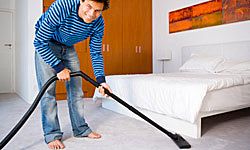A better night's sleep is only a few steps away. Here's what remains on your cleaning checklist:
Mattresses and Box Springs
Mattresses are usually made from foam or springs and casing; some older mattresses are made of hair, and futon mattresses are filled with cotton. All mattresses benefit from routine care. Every month, turn the mattress over and around end to end to ensure even wear.
Cover your mattresses with quilted or rubberized covers to prevent soiling. Remove spots and stains promptly, but do not allow the mattress to become excessively wet when you clean it. Do not make the bed until the mattress is fully dry.
Pillows
Pillowcases are routinely replaced when soiled bed linens are changed, but the pillow itself also requires regular cleaning. Know the pillow's filling -- down, feather, foam, polyester, or kapok -- so that you use the appropriate cleaning method. For polyester-filled pillows, read the care instruction tags; some polyester-filled pillows are washable, while others are not. Kapok is the silky covering of seeds from the ceiba tree; pillows with this stuffing need frequent airing but cannot be washed.
You'll also want to adhere to the following guidelines:
- Protect each pillow with a zip-on cotton or polyester cover.
- Refresh pillows once a month by airing them near an open window or hanging them on a clothesline.
- Fluff feather and down pillows daily to get rid of dust and to redistribute the filling.
- Before you wash feather or down pillows, make sure there are no holes or ripped seams. Machine- or hand-wash feather and down pillows in cool water with a light-duty detergent. Wash two pillows at a time, or add a couple of bath towels to balance the load.
- Dry down and feather pillows in the dryer on the low-heat setting. Including a pair of clean, dry tennis shoes in the dryer will help distribute the down as it dries.
- Hand-wash and line-dry foam pillows. Change the hanging position hourly to dry the filling evenly. Never put a foam pillow in the dryer.
- Machine- or hand-wash polyester-filled pillows in warm water with an all-purpose detergent. Dry the pillows in the dryer on a moderate heat setting.
If you follow the simple steps we've outlined in this article, your bedding should remain in great shape. And, by virtue of being more comfortable in your bed, you should remain in great shape, too.
Learn more about how to clean your bedding by following the links on the next page.
